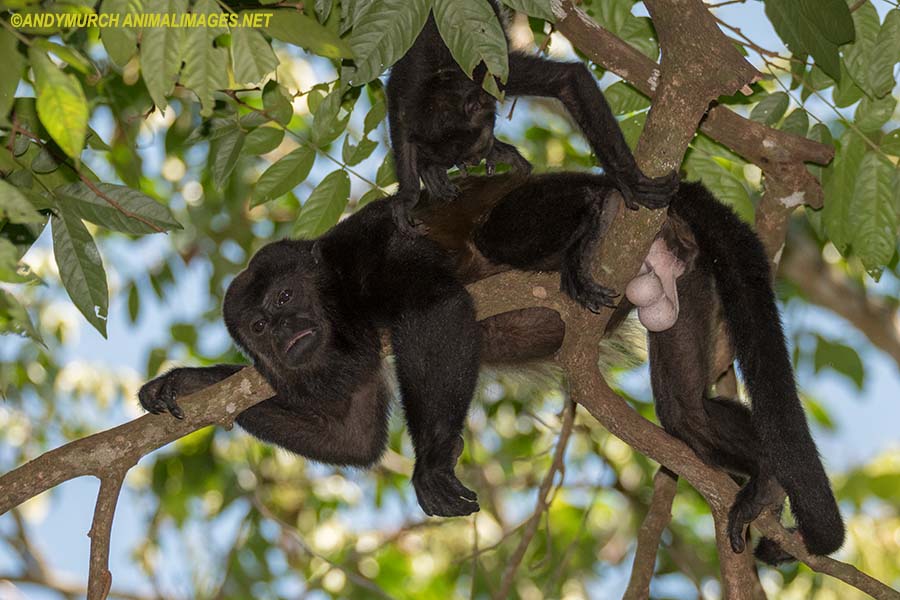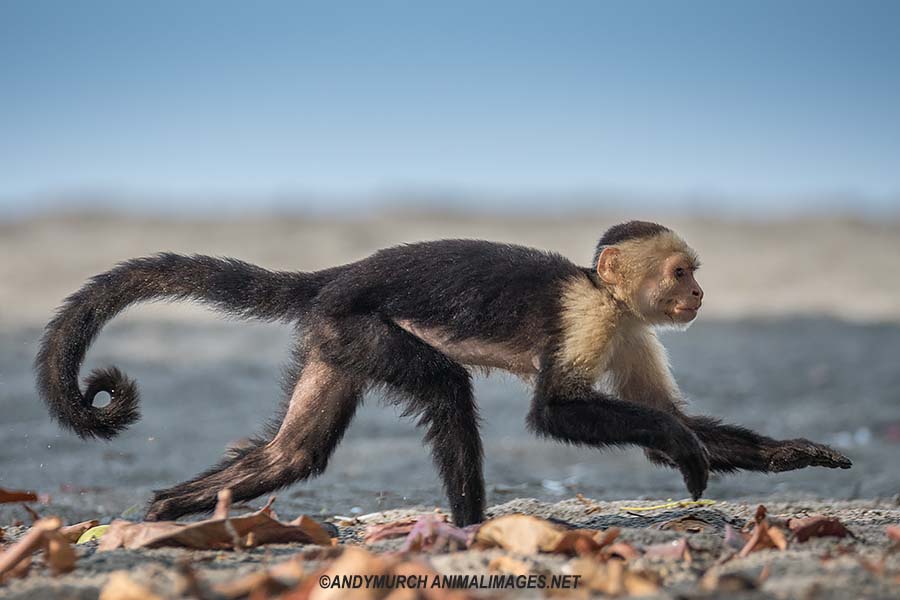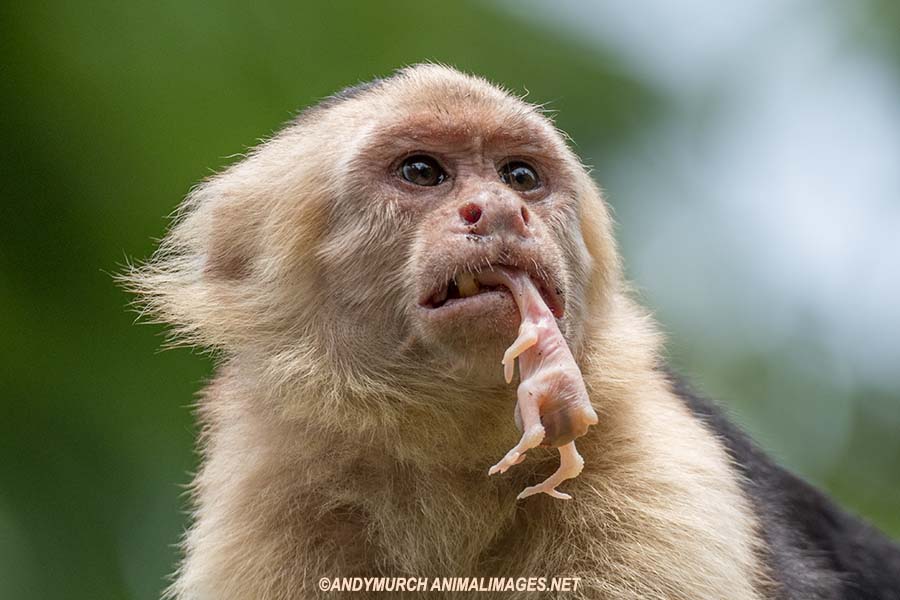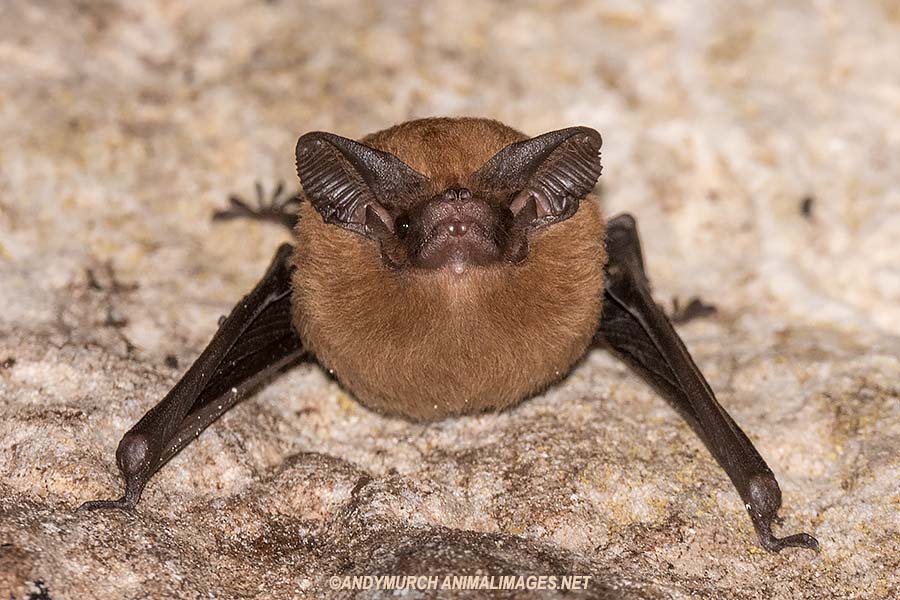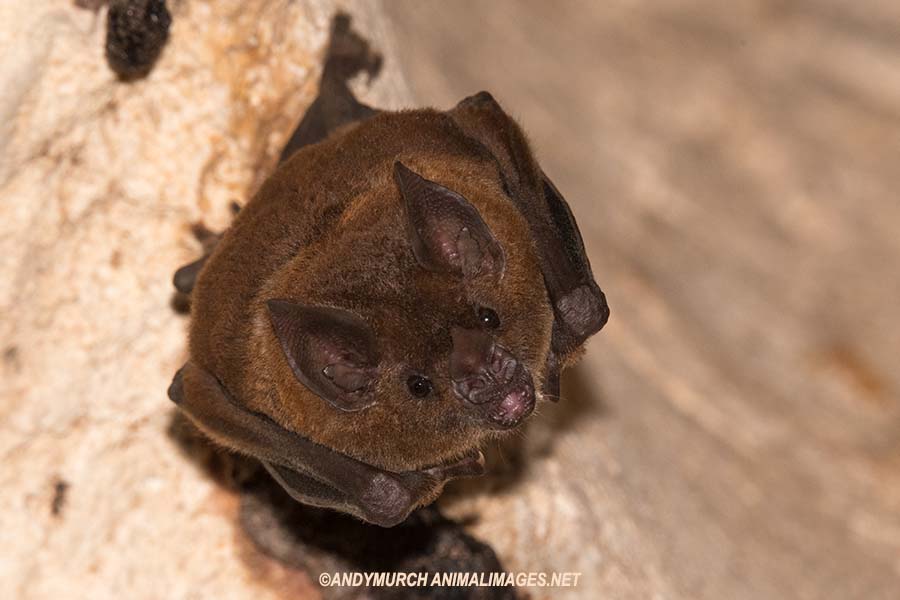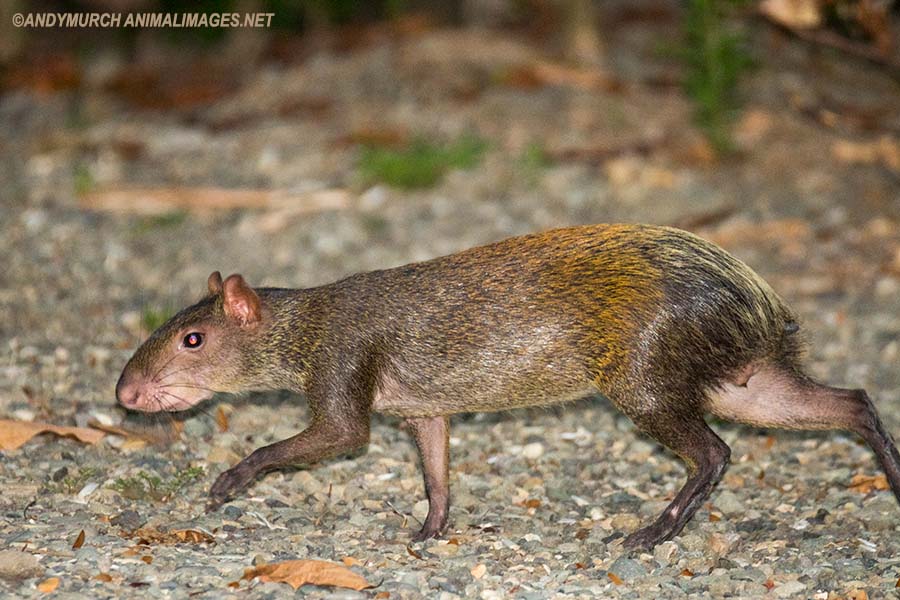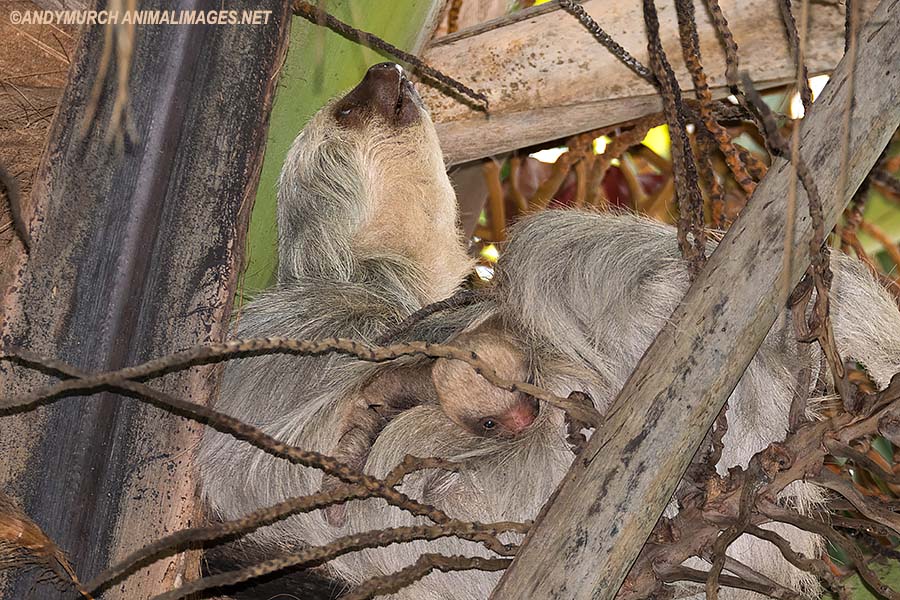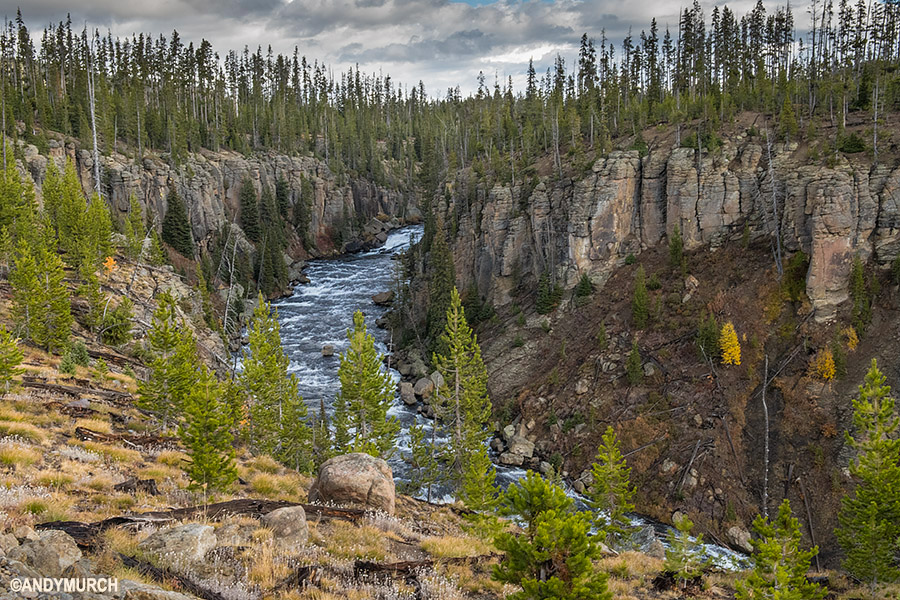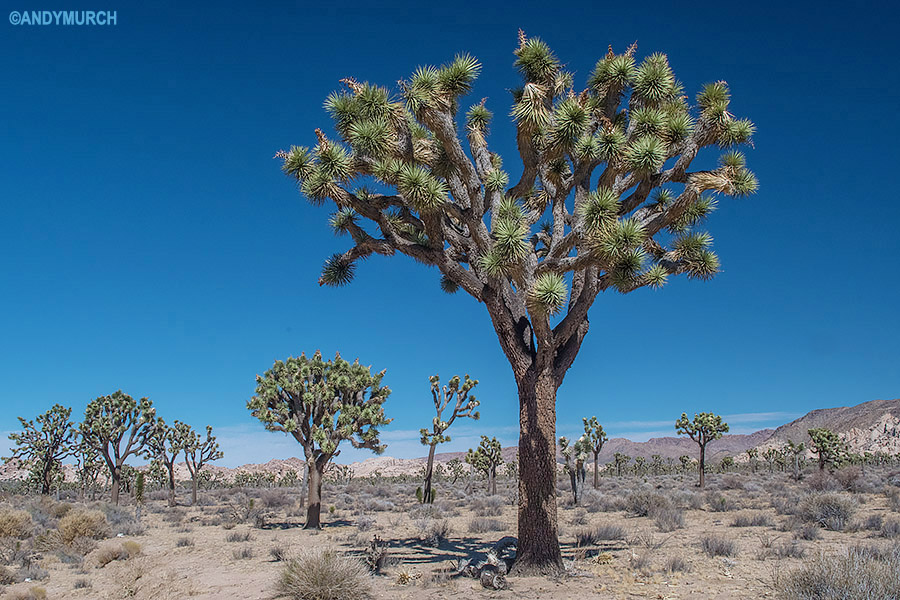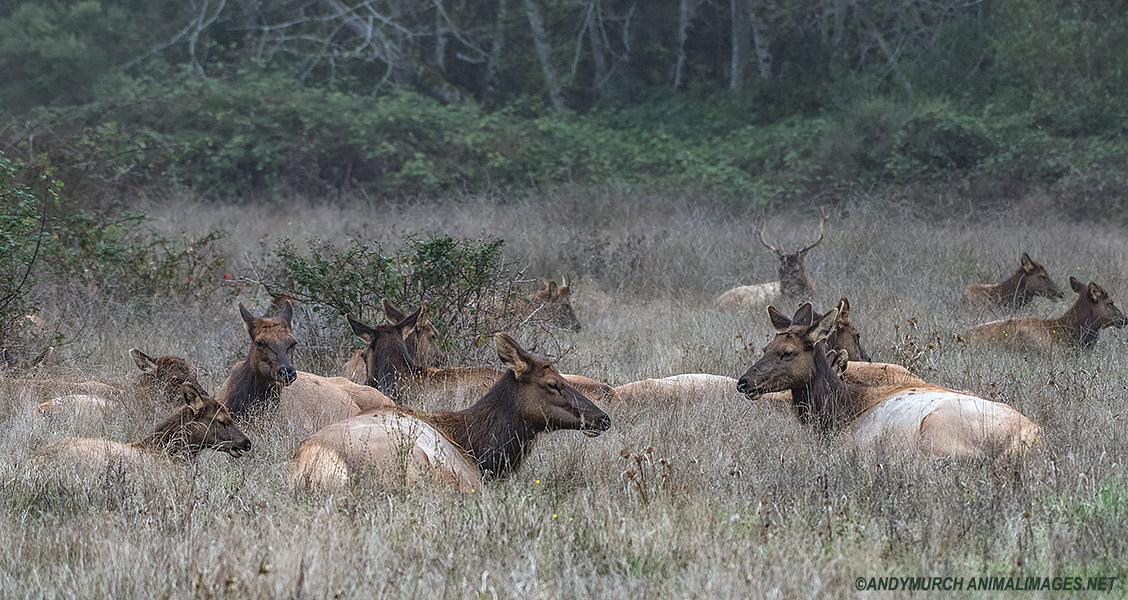MANUEL ANTONIO / QUEPOS AREA, COSTA RICA
Duration: 2 Days. April 2-3 2019
Mammals encountered: 14 species
Mammals Photographed: 12 species
Officially, this was not a mammal photography trip but rather an add-on after a marine expedition looking for the newly described and rarely seen Pacific Nurse Shark. With only two days to chase mammals, I chose to concentrate on two of my favorite groups: primates and bats.
PRIMATES
I hired Maurilio Cordero (an excellent local guide) to help me find the primates I was looking for. Rather than enter Manuel Antonio National Park, Maurilio instructed me to drive slowly along the roads near the park entrance while he listened intently for the chirping sounds of Central American Squirrel Monkeys. How he could hear them among the cacophony of bird song is beyond me. Even when we stopped near a large troop, I had trouble picking out their particular notes but he could spot their high pitched squeaks from 100m away.
Once we found a troop, I was glad we were outside the park boundary because we would have been restricted to the trails rather than bushwacking our way through the jungle, and it meant I could use a fill flash which is not permitted in the park.
During the first and second mornings, Maurilio found 4 or maybe 5 different troops. One troop appeared to have at least 30 animals. Each time we heard squirrel monkeys, we parked the car and followed them on foot through the dense jungle as they foraged for food. CASMs move quite quickly and forage over large areas so the hiking was tough but also very rewarding, with numerous close encounters that yielded hundreds of photographs of this beautiful species: Central American Squirrel Monkeys.
While chasing squirrel monkeys, we also came across a couple of troops of Mantled Howler Monkeys. Mostly they kept quite high in the canopy but now and then one would come a bit lower where I was able to get some decent pics.
The other species that are readily accessible around Manuel Antonio N.P. are Panamanian White Faced Capuchins. They are not at all shy so it was easy to follow them along the beach and through the mangrove while they stole fruits from nearby plantations or bit the heads off lizards that they pounced on like cats.
On the second morning, we had hiked up to a jungle covered ridge-line in pursuit of a troop of squirrel monkeys. Some capuchins were working the same patch of forest but I ignored them in favour of their subjectively prettier cousins. Suddenly, a large white-faced capuchin lept onto a branch in front of me with a chick swinging from its teeth. Maurilio told me this was unusual behavior because they usually eat their food on the spot. I once watched an alpha male chimp strutting around with a colobus monkey hanging from his mouth and I wondered if this might be the same type of dominance display.
BATS
On the afternoon of our second day, we visited a bat cave on a palm plantation near Damas, around 20km from Manuel Antonio N.P.
The cave is on private land but Maurilio was able to arrange permission. It was a challenge to reach the entrance in my little 2WD rental car, but we eventually made it and later returned safely back to the highway in one piece.
At the cave entrance, there were a few Greater White-lined Bats and Lesser Doglike Bats clinging to the walls.
Within the cave, we found a few small colonies of Common Vampire Bats. When I shined my light on them, rather than fly away, they scuttled into the shadows in true vampire form! 
There were also pockets of dark skinned Greater Spear-nosed Bats; perhaps a few hundred animals in total.
But by far the most abundant bats were one or more species of Carollia. According to Fiona Reid’s excellent field guide to the Mammals of Central America and Southeast Mexico, there are three Carollia species potentially present in this part of Costa Rica:
- Chestnut short-tailed bats – C.castanea
- Seba’s short-tailed bats – C.perspicillata
- Sowell’s short-tailed bats – C.sowelli
Fiona does not list C.sowelli as roosting in caves but I considered them in the ID process anyway. Some roosting groups looked quite different from others, so I hoped there were at least two species of Carollia in the cave but definitive identification of the members of this genus is quite difficult. It isn’t possible to identify individual species based on colour, even though colour variants in this cave seem to group together. C.perspicillata in particular can be grey-brown, dull brown, or bright orange and that narrows it down to all of the bats that were present 
If you have a chance to handle the bats to determine the amount of tricoloration in the undercoat, that would be more definitive, but I didn’t try to catch any. So, I was left with analysis of ‘forearm hairiness’. These are the options according to Fiona’s book:
- C.castanea = naked forearms.
- C.sowelli = base of the forearms velvety, covered in very short hair.
- C.perspicillata = base of forearms lightly haired with very short hair.
I took a lot of reasonably sharp images so I had plenty of pics to scrutinize. The reddish Carollias had the most obviously hairy forearms, so I am pretty sure they were Seba’s Short-tailed Bats. Some of the grey-brown ones had pinker forearms that looked hairless at first glance. But on closer inspection, almost all had a fine covering of hair to one degree or another. So it comes down to interpretation: Is almost no visible hair the same as naked? Or, is an almost invisible amount of flat-lying hair considered velvety? Or, lightly-haired?
Based on the slight amount of hair and cave habitat, I am listing them all as Seba’s short-tailed bats for now but it is hard to believe that these two animals are the same species. If you know your bats, please let me know what you think:
OTHER MAMMALS
We spotted one Crab-eating Racoon on a side road while we were hightailing it after squirrel monkeys, and a White-nosed Coati while photographing mantled howlers, but I was too absorbed with monkey business to get shots of either species.
While hunting in the mangrove, I did stop watching the capuchins long enough to snap a few images of Central American Agouti, of which we saw 5 in total.
Hoffmann’s Two-toed Sloths and Brown-throated Three-toed Sloths were both relatively abundant when we took the time to look for them. Or rather, when Maurilio looked for them, because apparently I wouldn’t be able to find a sloth if it fell on me. For larger animals, they are extremely good at disappearing into the tangles of vines and twigs that build up in the forks of trees.
We saw 7 or 8 of each species in a single morning. Not bad considering we spent barely any time looking for them.
That was pretty much it other than some Variegated Squirrels at our hotel near the airport in San Jose. I would have liked to look for silky anteaters in the mangrove around Manuel Antonio but there was no time. Fortunately, I’ll be back in Costa Rica next year running a scuba-diving expedition with humpback whales so I will have plenty more chances to nail some rarer critters.
Trip List:
- Greater White-lined Bat – Saccopteryx bilineata
- Lesser Doglike Bat – Peropteryx macrotis
- Seba’s Short-tailed Bat – Carollia perspicillata
- Common Vampire Bat – Desmodus rotundus
- Greater Spear-nosed Bat – Phyllostomus hastatus
- Brown-throated Three-toed Sloth – Bradypus variegatus
- Hoffmann’s Two-toed Sloth – Choepus hoffmanni
- Mantled Howler Monkey – Alouatta palliata
- Panamanian White-faced Capuchin -Cebus imitator
- Central American Squirrel Monkey – Saimiri oerstedii
- Central American Agouti – Dasyprocta punctata
- Variegated Squirrel – Sciurus variegatoides
- Crab-eating Racoon – Procyon cancrivorus
- White-nosed Coati – Nasua narica
Andy Murch
Trip Leader Bigfishexpeditions.com
]]>RWANDA & UGANDA PRIMATE SAFARI JULY 2018 TRIP REPORT
Trip Duration: July 2-26 2018
Mammals encountered: 42 species
Mammals Photographed: 39 species
There are no adjectives that can adequately describe the diversity and sheer biomass of animals, or the quality and intensity of the encounters that can be enjoyed in Uganda. Our main focus was primates and we were not disappointed. We encountered 15 species of primates and photographed 14 of those at close range.
Our game drives were also extremely rewarding, especially in Murchison Falls National Park which supports enormous herds of antelopes, buffalo, giraffes and elephants, and a decent amount of predators.
This was one or our guest trips but before the guests arrived, We (My wife Laura and I) had a few days to explore Nyungwe N.P. in Rwanda and Mgahinga N.P. just across the border at the southern tip of Uganda. Nyungwe is a great place to see habituated Angolan Colobus Monkeys. Sometimes you can see an extremely large troop but shortly before we arrived, chimpanzees had been hunting them so they had fragmented into family units. Regardless, the dozen or so that we came across allowed us to get extremely close for some good photo ops. I would have liked more time there to track down some other primates but Uganda was calling.

In Mgahinga N.P. the Golden Monkeys were easy to locate towards the top of the volcano in and around the large bamboo zone that dominates at higher elevations. There were perhaps 50 individuals loosely grouped together.

After Mgahinga, we continues north to Entebbe to meet our guests and begin the official part of the tour. We conducted two 9 day trips. Almost all of the animals shown below were seen by both groups. One group got better rhinos, the other got better lions. That’s nature but no one went home disappointed. The term ‘Life Changing Trip’ got thrown around more on this expedition than any other trip we’ve done. I am looking forward to getting back there next year to do it all over again.
Here is what we saw:
Eastern Mountain Gorillas! This what is was all about and the gorilla encounters in Bwindi Impenetrable Forests were excellent as usual. They sat, they ate, they swung from trees, they brushed past us and one even grabbed one of our guests by the t-shirt and tried to lead her off into the jungle. For a minute I thought she might go along with it 

Gorilla trekking isn’t a walk in the park. Its hard work hiking up through the cloud forest to where the gorillas are feeding, but the terrain in Bwindi Impenetrable Forest makes the journey as magical as the encounters themselves.
Chimpanzees. Spending time in Kibale National Park with our closest relatives was a real highlight of the trip.
Their human-like expressions suck you in. I cannot help but wonder what this chimp is thinking. Is he sad, happy, or just at peace?

Last year, we came upon a troop of chimpanzees that had just killed a colobus monkey so they were riled up and running across the forest floor slapping trees and screaming at eachother. The alpha male even charged me with the remains of the monkey in its mouth and slapped the nearest tree as he brushed passed me. This year the chimpanzees were more spread out and relaxed so it was a better time to watch them grooming one another, or waiting patiently for food; larger chimps will wait until a smaller chimp is finished with a piece of fruit rather than stealing it. We saw perhaps 20 chimps in total but sometimes they come together to form a troop that can be 100 animals strong.
Olive Baboons. These guys were everywhere we went; in the forest, on the savannah, hanging out on the country roads and sadly, often rummaging through garbage cans. They like open spaces where they can see predators from a distance but they are always ready to slip back into the forest at a moment’s notice e.g. if the alpha-male screams at them.
While we were taking a boat ride on the Kazinga Channel in Queen Elizabeth National Park, we spotted a troop of baboons raiding weaver bird nests along the bank. The baboons would pick a tree with lots of nests and rip the whole nest out of the tree, then tear it open and eat the eggs; probably the chicks too.

Patas Monkeys These unusual monkeys are the cheetahs of the primate world. They live on the savannah where there are not many trees so they have had to pick up the pace. When chased by a predator they can run at speeds of more than 50kmh.
In Murchison Falls N.P. patas monkeys are relatively common. We saw around a dozen. One was in a tree but we usually saw them sitting on top of termite mounds where they have a good chance to spot lions creeping up on them through the tall grass.

Blue Monkeys We saw these cute but elusive primates in Bwindi Impenetrable Forest while gorilla trekking. Until recently, blue monkeys were considered a subspecies of Sykes monkey, as was the golden monkey; the species that we saw in Mgahinga.
These ones were in a small family unit of about 6 individuals, high in the trees, about half way up the mountain above the Buhoma Camp entrance to the park.
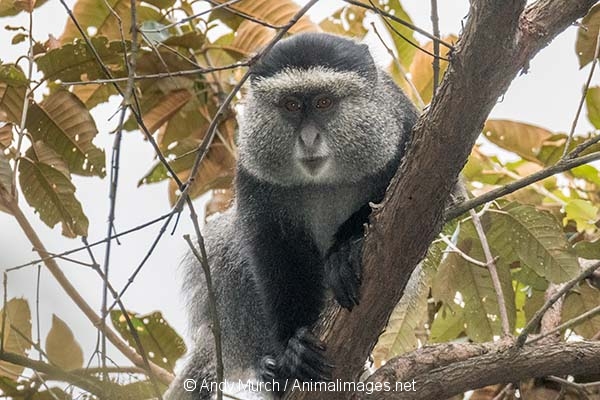
L’Hoests Monkeys. We saw these monkeys in Bwindi as well but we had much better encounters during our swamp walks around Kibale N.P.
We also saw them on our way in and out of Nyungwe N.P. in Rwanda, sitting at the sides of the road. I am not sure if they do this because they like open spaces or because they are hoping for handouts. We didn’t see anyone feeding them but I suspect that’s why they’re there.

The swamp tours were excellent for primate diversity. Each time we saw L’Hoests, redtailed monkeys, ashy red colobus monkeys, Guereza Colobus monkeys (aka black and white colobus monkeys) and Ugandan Crested Mangabeys.
Redtailed Monkey

Ashy Red Colobus Monkey

Guereza Colobus Monkey

Ugandan Crested Mangabey

We conducted two night walks in Kibale. On our first night walk we spotted a few Thomas’s Dwarf Galegos and one Demidof’s Dwarf Galego. Unfortunately, I didn’t get shots of either because they’re fast little monkeys and not keen on spotlights.
On our second walk there were no Demidof’s (images of that species still elude me) but I managed to photograph the larger Thomas’s Dwarf Galego when it froze for a few seconds mesmerized by our torches.

The Tantalus Monkey Finishing up the primate list for this year is the tantalus monkey. Vervet monkey species are rather hard to identify accurately in the field but based on location, I think these guys are tantalus monkeys rather than vervet monkeys, green monkeys or grivet monkeys. Either way, they are quite common primates throughout southern Uganda, and not camera shy. We saw troops of them in or near each park that we visited.

For our other mammal sightings, I’ll switch to a conventional timeline:
First stop out of Kampala was Ziwa Rhino Sanctuary; a small reserve where you can literally walk with wild White Rhinos.
We also bumped into a large herd of domesticated Ankole Cattle. This ancient breed has massive horns and is considered a separate sub-species from all other cows: Bos taurus africanus.
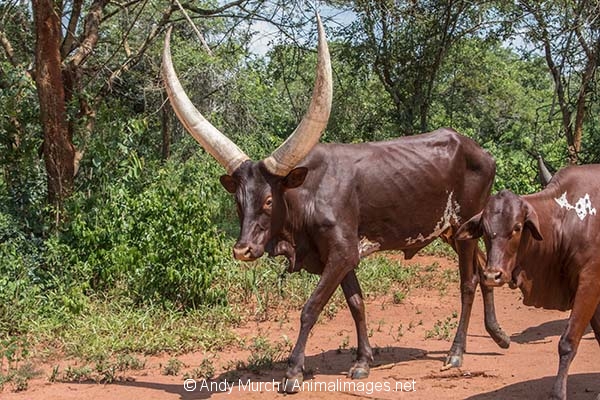
Our second destination was Murchison Falls National Park – one of the most spectacular parks in this part of Africa.
It is tough to find a spot anywhere within this enormous protected area where you won’t see animals of one description or another. The park boasts more than 900 Rothschild Giraffes, 40,000 Uganda Kob, 1400 African Bush Elephants, huge herds of Cape Buffalo, Hartebeests, Oribi and so much more.
Hartebeest

Rothschild’s Giraffes

Cape Buffalo
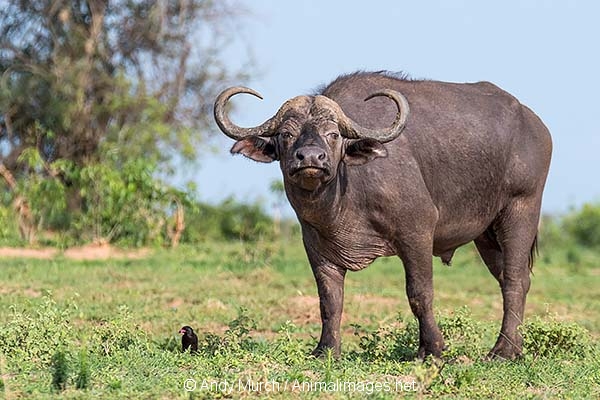
Some of the 40,000 Kob in the park.

Waterbuck (do you think they’ve seen us?)

A rather shy Cape Bushbuck. Not uncommon but they soon disappear once discovered.
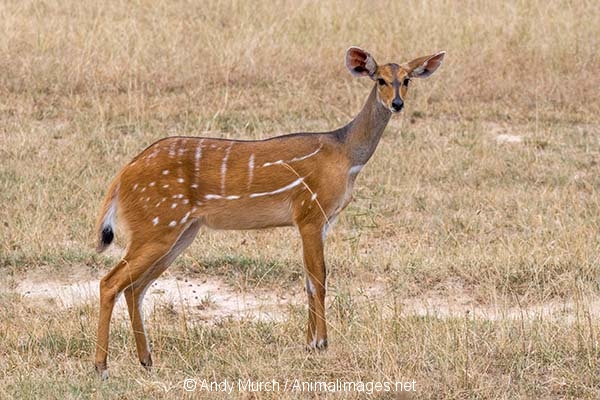
Bohor Reedbucks on the Savannah. First time I’ve seen this species in Uganda.
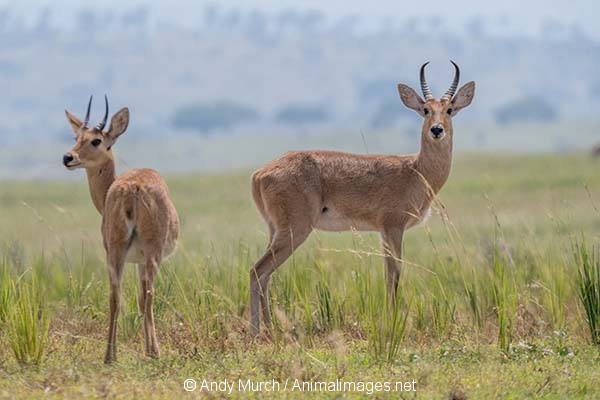
Oribi There are thousands of these pretty little antelopes running around in Murchison Falls N.P. but they are strangely absent in parks further south.

In the early morning, we also saw a couple of black-fronted duikers, but they saw us first and disappeared long before I could raise my camera.
Common Warthogs These guys were everywhere. Around the lodges, on the savannah and at the sides of the road. Hard to say how many we saw in total but it must have been in the hundreds. No matter how often I see them, their antics still make me smile.

On the subject of suids, in the evening we had a short encounter at the lodge with a family of bush pigs. Unlike warthogs, these are nocturnal forest dwellers and very shy around humans but they have a habit of cleaning up the vegetable scraps outside the staff quarters so getting images of them is not that hard.
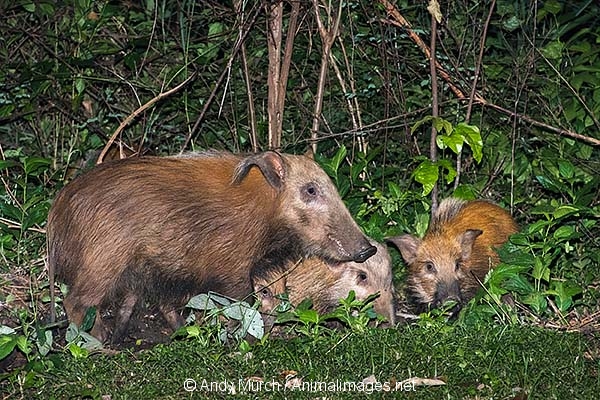
We also found a third species of suid, a family of large but secretive Giant Forest Hogs that disappeared into the forest as soon as they realized they were being observed.
African Bush Elephants. The herds in Murchison Falls can be huge. In one area we saw more than 100 individuals moving nose-to-tail along traditional migratory routes. In another region of the park, I would estimate there were a few hundreds more, stripping trees, mating and generally socializing. It was an impressive scene but hard to capture in its entirety. Individual portraits worked out a bit better.
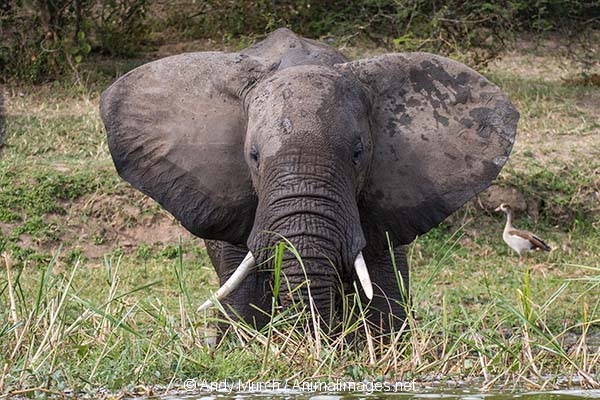
Spotted Hyenas This year we saw just one hyena in Murchison and another later in Queen Elizabeth N.P. but it was still nice to tick that box. Tree climbing Lions. We usually see quite a few lions in Murchison Falls but this one was a particularly nice encounter. Mom climbed up and waited for her fur balls to gingerly join her. They took a little coaxing and she finally went down and grabbed the bottom one by the scruff of his neck to lift him off the ground for that initial boost.

Finishing up the big cats, we also had a Leopard encounter albeit rather a distant one.
Of course, we stopped in at the falls themselves, to enjoy the sheer power and visual spectacle. No mammals to note but it’s a great place to photograph yellow headed agama lizards.

After Murchison Falls N.P. we moved to Kibale N.P. where we saw many of the primate species of the trip. Then we continued onward to Queen Elizabeth National Park. During the drives we saw many of the animals that we had seen in Murchison but in a drier, grassier environment. One notable addition was a small herd of Topi antelope in the southern reaches of the park.
The real highlight of Queen Elizabeth N.P. is the river cruise on the Kazinga Channel. Being a fairly arid park, much of the wildlife congregates along the shoreline. The riverboats get quite close so there are endless great photographic opportunities.
African Forest Buffalos and Cape Buffalos laze around in large groups on the shore or wallow at the edges, seemingly oblivious to Nile Crocodiles swimming around them. I sometimes hear Forest buffalos referred to as a unique species but the general consensus is still that they are a subspecies of cape buffalo. In Queen Elizabeth, the two versions readily hybridise so the reddish animals you often see along the shores of the Kazinga Channel are unlikely to be 100% forest buffalo. Regardless, they are very different looking from their darker, southern kin.

The channel also holds elephants galore that constantly wander in and out of the bush. There are African forest elephants in Uganda but not here. These ones are simply African bush elephants that live in the forest. Perhaps most iconic in Kazinga are the herds of hippopotomus. Rafts of these enormous, extremely aggressive animals float close to shore, duck diving occasionally to munch on aquatic vegetation. There were so many, I believe you could run on their backs to shore but I decided not to try it 
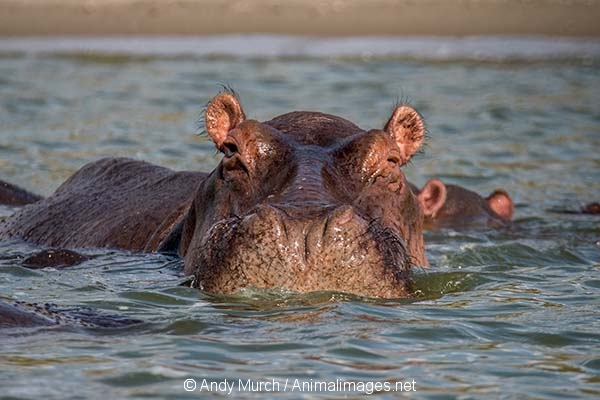
A fun side trip while in Queen Elizabeeth N.P. is a visit to a small village near the boat launch to the Kazinga Channel. Here there is a habituated family of Banded Mongooses that you can get extremely close to. Since last year, storks and other large avian predators have been predating on the young of the year so the family has shrunk from 20 something to 15 individuals. The mongooses now have a human guard that follows them around all day to scare off attackers but tourists can still get as close as they want.
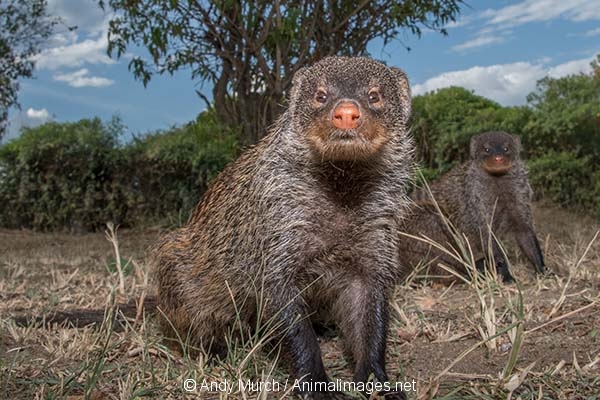
Speaking of mongooses, while chasing the bushpigs in Murchison Falls, I spotted a dark brown mongoose foraging in the grounds of the lodge. Since the trip, some more learned folks than me have identified it as a White-tailed Mongoose – Ichneumia albicauda even though this particular animal has a black tail.

We did not have time to hunt for any smaller mammals but we did see a few squirrels and rabbits. In Murchison we came across a couple of Striped Ground Squirrels and in Bwindi we spotted some reddish tree squirrels that could have been virtually any species that occur there.
No pics of the striped ground squirrels this year so I’m sneaking in an image from our 2017 Uganda trip.

On the way back to Entebbe we had two nice surprises. The first was a tree filled with hundreds of roosting Straw-coloured Bats. We came across them about 3hrs north of Bwindi N.P. on a back road somewhere before you connect to the main road that runs to Kampala. FYI, we saw lots of other bats in the evenings but none that I could positively identify as they were all in flight and I wasn’t carrying a bat detector.

The final surprise was a herd of Plains Zebra at the edge of Lake Mburu N.P. We were not actually visiting the park; we were just driving by on our way home but the zebras were right on the park boundary so we stopped and enjoyed them for a while.

Mammal-wise, that was our 2018 trip. Can’t wait to get back there next year! I’m especially excited about including a night drive in Murchison, which should yield some interesting new critters!
Our Mammal list: 42 Species
PRIMATES
Eastern Gorilla – Gorilla beringei
Chimpanzee – Simia troglodytes
Olive Baboon – Papio anubis
Uganda Crested Mangabey – Lophocebus ugandae
Guereza Colobus – Colobus guereza
Angolan Colobus – Colobus angolensis
Ashy Red Colobus – Piliocolobus tephrosceles
Red–tailed Monkey – Cercopithecus ascanius
Blue Monkey – Cercopithecus mitis
Golden Monkey – Cercopithecus kandti
Patas Monkey – Erythrocebus patas
Tantalus Monkey – Chlorocebus tantalus
L’Hoest’s Monkey – Cercopithecus lhoesti
Thomas’s Dwarf Galago – Galagoides thomasi
Demidof’s Dwarf Galago – Galagoides demidovii
UNGULATES
African Bush Elephant – Loxodonta africana
White Rhinoceros – Ceratotherium simum
Commo Warthog – Phacochoerus africanus
Bush Pig – Potamochoerus larvatus
Giant Forest Hog – Hylochoerus meinertzhageni
Giraffe – Giraffa camelopardalis
Plains Zebra – Equus quagga
Common Hippopotamus – Hippopotamus amphibius
Cape Buffalo – Syncerus caffer
Ankole Cattle – Bos Taurus africanus (yes, I’m counting these)
Waterbuck – Kobus ellipsiprymnus
Kob – Kobus kob
Cape Bushbuck / Imbabala – Tragelaphus sylvaticus
Bohor Reebuck – Redunca redunca
Oribi – Ourebia ourebi
Hartebeest – Alcelaphus buselaphus
Topi / Tsessebe – Damaliscus lunatus jimela
Black-fronted Duiker – Cephalophus nigrifrons
RODENTS AND LAGAMORPHS
Striped Ground Squirrel – Xerus erythropus
Tree Squirrel sp. – Possibly Heliosciurus sp.
Bunyoro Rabbit – Poelagus marjorita (tentative ID)
BATS
Straw Coloured Fruit Bat – Eidolon helvum
CARNIVORES
Lion – Panthera leo
Leopard – Panthera pardus
Spotted Hyena – Crocuta crocuta
Banded Mongoose – Mungos mungo
White-tailed Mongoose – Ichneumia albicauda
Andy Murch – Trip Leader Bigfishexpeditions.com
Mammals encountered: 35 species
Mammals Photographed: 33 species
Highlights: Excellent leopard encounters, hunting jungle cats, a sloth bear and all five Sri Lankan Primates including both species of slender loris and pygmy blue whales underwater!
We knew this was going to be a great week as soon as we were picked up by our expert guide Dulan at the airport. It was around 9pm and we were exhausted from our international flights. We were supposed to go straight to a safari camp bordering Wilpattu National Park; a three hour drive to the west. After introductions, Dulan asked if we wanted to go spotlighting for nocturnal mammals on the way to the camp. We eagerly agreed!
That night we made numerous detours to Dulan’s secret spots. We didn’t reach the camp until the middle of the night but that was fine because on the way we got our first taste of Sri Lanka’s amazing biodiversity including our first jungle cat. It was a little distant for my strobe to light well but it was fascinating watching it work its way through the grassland in search of rodents to eat.

Jungle Cat – Felis Chaus
We also saw a Red Slender Loris feeding on fruit as we walked down an unpaved road surrounded on either side by dense trees. The tiny primate – about 20cm tall – initially hid behind some branches but Dulan started squeaking at it and it soon poked its head out to see what strange creature was making the noise. Over the next few days, Dulan’s bizarre animal call never failed to attract the critters we were after.

Red Slender Loris – Loris tardigradus.
Exhausted, we decided to call it a night. Arriving soon afterwards at the camp, we were pleasantly surprised to see that our tented accommodation wasn’t exactly ‘roughing it’ 

Roughing it at Wilpattu Safari Camp 
Wilpattu National Park
Our second day started with a hike around the edges of the park. As expected, by midmorning there were not a lot of large mammals out and about except distant Elephants within the park boundary.

Sri Lankan Elephant – Elephas maximus maximus.
However, there were some toque macaques in nearby trees and a few foraging grizzled giant squirrels. These are about three times the size of your average North American or European tree squirrel and quite easy to approach.

Grizzled Giant Squirrel – Ratufa macroura.
At noon we went by jeep deep into the park. Wilpattu is a beautiful region with a diverse assortment of animals and bird species.

Wild Water Buffalo in Wilpattu National Park.
Unlike Yala and many other dry zone protected areas, the park is heavily forested. This makes it a little harder to spot wildlife but also means that there is a higher density of animals and birds because the habitat is more pristine.
It didn’t take long for us to locate many of the common fauna including wild boar, Asian elephants, herds of chital (white-spotted deer) and small groups of wild water buffalo. Most Sri Lankan buffalo are feral domestic buffalo – Bubalus bubalis, or a genetic mixture of the two species. However, the buffalo in Wilpattu are almost all genetically pure wild buffalo – Bubalus arnee. You can easily tell the difference by their wide outstretched horns. Their domestic cousin’s horns generally curve upward and inwards.

Wild Water Buffalo – Bubalus arnee.
Although we were concentrating on mammals, there were plenty of reptiles present including mugger crocodiles around the lakes and green and grey vine snakes in the trees and bushes.

Mugger Crocodile – Crocodylus palustris
There were reports of leopard sightings and we found fresh tracks across many of the trails but we left the park around 6pm without seeing Sri Lanka’s largest land predator. After supper we went on an intensive spotlighting trip around the periphery of the park. During that session we found lots of small animals including palm civets, a white-lined chevrotain but the highlight was a Gray Slender Loris that Dulan spotted in a tree on the edge of a chilli pepper field. Keeping a close eye on the undergrowth for snakes, we ventured into the bush for a closer look and the loris obliged very nicely 

Gray Slender Loris – Loris lydekkerianus.
Early the next morning we drove back into the park. After about an hour we picked up the trail of a young male Sri Lankan leopard and waited for him to materialize out of the undergrowth. Eventually he did and we watched him for some time as he loped along the edge of the dense jungle. Eventually he slipped away but not before I had fired off plenty of images.

Sri Lankan Leopard – Panthera pardus kotiya.
Once the leopard was gone we went in search of other species but we got anoher great sighting later in the day. Other than leopards we saw an impressive list of mammals including a few ruddy mongooses, small troops of grey langurs, a handful of flighty Indian muntjac that I couldn’t get a picture of no matter how quickly I tried, numerous sambar deer and a solitary, distant sloth bear – my first but hopefully not my last!

Sloth Bear – Melursus ursinus.

Sri Lankan Ruddy Mongoose – Herpestes smithii zeylanicus.
After a sumptuous lunch of local curry dishes, we left Wilpattu and headed for Sigiriya in the centre of Sri Lanka’s northern dry-zone forests. We were hoping to find fishing cats but sadly we were thwarted by the excessive rains that fell much later than expected. However, while in Sigiriya we found plenty of other animals to keep us busy including Sri Lanka’s fifth and final primate species; the purple faced leaf-eater monkey.

Purple Faced Leaf Monkey – Trachypithecus vetulus.
By day we encountered endless monkeys, elephants, small herds of chital and mongooses. There are four species of mongooses in Sri Lanka. The most common are Ruddy Mongooses but we also saw a mother and baby Indian Grey Mongoose.

Indian Grey Mongoose – Herpestes edwardsii.
Dulan also took us to a couple of remote budist temples and a disused storage shed where we were able to photograph some of Sri Lanka’s many bat species including Schneider’s Leafnosed Bats, Rufous Horseshoe Bats, Black-bearded Tomb Bats and Lesser False Vampire Bats.

Schneider’s Leaf-nosed Bat – Hipposideros speoris.
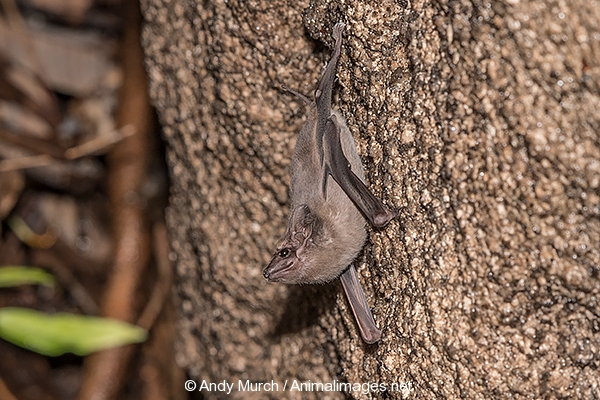
Black-bearded Tomb Bat – Taphozous melanopogon.

Rufous Horseshoe Bat – Rhinolophus rouxii.

Lesser False Vampire Bat – Megaderma spasma.
By night we scoured the forests and fields around Sigiriya for cats and civets. For the uninitiated, civets are distantly related to cats. They usually live in trees where they hunt for birds, reptiles and small mammals. Dulan thought he saw a few palm civets but the most common and the most striking civets that we found were Small Indian Civets.

Small Indian Civet – Viverricula indica.
While scanning the edges of fields we also picked out numerous Asiatic Long-tailed Climbing Mice precariously perched on the ends of grass stalks gathering seeds.

Asiatic Long-Tailed Climbing Mouse – Vandeleuria oleracea.
Most of the mammals we saw fell under the category of ‘the usual suspects’ for Dulan but he was surprised to see a trio of Pouched Tomb Bats taking a nap on the trunk of a large tree at the side of the road.

Pouched Tomb Bats – Saccolaimus saccolaimus.
On the reptile front, we saw many Bengal land monitors and more vine snakes plus a mildly venomous Forsten’s Cat Snake.

Forsten’s Cat Snake – Boiga forsteni.
By day, there were also numerous turtles in the bush, including Indian Flapshell Turtles and Indian Star Tortoises. It was nice to see that they haven’t all been collected for the pet trade.

Indian Flapshell Turtle & Indian Star Tortoise.
On a regular week long trip we would have gone south after Sigiriya to hunt for some of Sri Lanka’s other endemic mammal species that are confined to wet-zone forests but this year was just a short add on to our Sri Lankan Blue Whale Expedition so after five days we returned to Colombo and went in search of whales. Next year we will run a full length Safari with all of Sri Lanka’s Iconic Mammal Species.
Before we arrived back in Colombo, Dulan had one more treat for us; stopping at the side of the highway he led us to a stand of large trees crammed with hundreds of Indian Flying Foxes.

Indian Flying Fox – Pteropus giganteus.
That night we said our goodbyes to Dulan and headed out to sea. We spent the following five days in the company of Sri Lanka’s abundant Pygmy Blue Whales. This was my third year running blue whale snorkelling trips. Its generally not that easy to get close to fast moving whales but this year proved to be an epic adventure with daily world class blue whale encounters.

Pygmy Blue Whale – Balaenoptera musculus brevicauda.
We also ran into a few pods of shortfin pilot whales and long beak common dolphins but the blue whales dominated the trip. At one point we had a group of three blue whales making pass after pass. The world’s largest whales generally ignore snorkelers but this group took great interest in us for a couple hours – an experience none of us on the trip will ever forget. You can read more about our 2017 blue whale week on Big Fish Expeditions: Blue Whale Trip Report
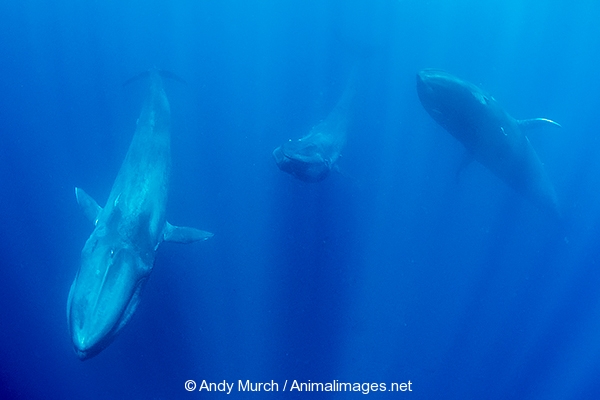
A little distant but its not easy to get three blue whales in a single frame 
In 2018 we’ll be back in Sri Lanka running another mammal watching safari. Join us there: Sri Lanka Mammal Safari 2018

Andy Murch is an accomplished Marine and Terrestrial Wildlife Photographer and Trip Leader at Big Fish Expeditions.
Mammal Species Seen during the expedition:
Sri Lankan Leopard
Jungle Cat
Small Indian Civet
Ruddy Mongoose
Grey Mongoose
Grizzled Giant Squirrel
Three lined Palm Squirrel
Indian Giant Flying Squirrel (eye shine only)
Asiatic Long-tailed Climbing Mouse
Indian Hare
Roufous Horseshoe Bat
Schneider’s Leaf-nosed Bat
Lesser False Vampire Bat
Indian Flying Fox
Black-bearded Tomb Bat
Pouched Tomb Bat
Purple Faced Leaf Eater Langur
Grey Langur
Toque Macaque
Red Slender Loris
Grey Slender Loris
Indian Muntjac
Chital Deer
Sambar Deer
White-lined Chevrotain
Wild Asian Water Buffalo
Domestic Water Buffalo
Asiatic Elephant
Wild Boar
Eurasian Otter
Sloth Bear
Asian Elephant
Shortfin Pilot Whale
Long-beak Common Dolphin
Pygmy Blue Whale
]]>
Mammals encountered: 32 species/subspecies
Mammals Photographed: 25 species/subspecies
This expedition was intended to be a ‘late summer’ wildlife photography trip, just before the snows hit the Rocky Mountains and made travel difficult. We didn’t quite have a snow-free trip but we mostly stayed ahead of the weather as it chased us south.
Over the course of a month, we drove (from our home on Vancouver island) through Yellowstone N.P., Grand Teton N.P., Arches N.P., Bryce Canyon N.P., Grand Canyon N.P., Saguaro N.P., Joshua Tree N.P., Redwoods N.P. and Mount St Helens National Volcanic Monument. It was a phenomenal trip!
Our first sighting occurred on the a ferry ride between Victoria and Port Angeles in Washington State. During the crossing we saw dals porpoises far away across the strait. Then we had a long drive southeast through Washington, Idaho, Montana and finally into Wyoming. Not much to report along the way other than a few Columbian black tailed deer and a couple of pronghorns.
Yellowstone National Park
We arrived in Yellowstone N.P. during the elk rut. There were scores of Rocky Mountain Elk all around the tourist centre at Mammoth Hot Springs. Each night that we camped nearby, we fell asleep to the erie sound of bucks bugling to their does – a wonderful sound.
While in the park, we also managed to photograph most of the usual suspects i.e. hundreds of enormous American bison, small herds of pronghorns in Lamar Valley, bighorn sheep (solitary rams and small flocks of ewes and lambs), mountain goats high up on seemingly unscalable cliffs, a couple of cinnamon black bears, countless mule deer, packs of telescopically distant grey wolves and some surprisingly friendly mountain coyotes. One coyote was particularly desensitized to humans and let me snap away while he hunted, posed and pounced upon unsuspecting rodents.
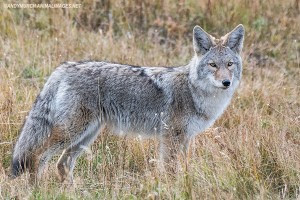
Mountain Coyote – Canis latrans lestes
But I digress. On this trip, we (my fiancee Laura and I) were on a mission to bag as many sciurids (squirrels, chipmunks and their kin) as we could find.
Being October, it was a bit late for marmots. Thats ok because we have designated 2017 as our ‘Year of the Marmot’ so we wandered the forests looking for their smaller cousins. We found two chipmunks and a couple of squirrels in Yellowstone. The first striped sciurid was a Least Chipmunk; very common in Yellowstone N.P.

Least Chipmunk – Tamias minimus
The second chippy (below) was a bit pale for a Least but I guess it could have been just a pale winter coat. Any offers?

Possibly a least chipmunk
The squirrels we encountered were all too fast to get images of, but I suspect they were just red squirrels.
Grand Teton National Park
After three days in Yellowstone, the weather deteriorated and the first snow fall of the year arrived. So, we drove down to Grand Teton but it was freezing there too. We decided to head even further south into the deserts of Utah to warm up, but not before photographing a Shiras Moose or two. While I fumbled with my SLR, Laura whipped out her iPhone and snapped this great image of a big bull moose walking right past our van:
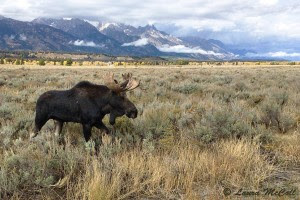
Shiras Moose – Alces alces shirasi
We continued south and spent the night in Northern Utah. That evening the wind howled incessantly around our van. The campground we chose was in the middle of nowhere and practically deserted. Apparently, we were the only campers foolish enough to brave the elements. The next morning we learned that a tornado had touched down right where we were camping – somehow I managed to sleep through the whole event 
Arches National Park
Our next stop was Arches National Park. Arches is a visually spectacular park if you like rock arches and other dramatic geological formations. However, it isn’t a particularly good place to see wildlife. Over the next two days, we saw lizards in abundance but not a lot of mammals. I was hoping for desert bighorn sheep but no luck. However, we did see quite a few hopi chipmunks and desert cottontails while hiking along Primitive Trail on the Devils Garden Loop.

Hopi Chipmunk – Neotamias rufus
Bryce Canyon
Those were the only mammals we saw in the entire park so we continued south to Bryce Canyon N.P.
Not far from Sunrise Point, there is sizeable colony of Utah prairie dogs. Unfortunately, the ‘stay on the path’ rules are quite strict in the park so I couldn’t get very close but it was fun watching them foraging near their warrens while one or two remained on high alert, ready to squeal at the first sign of danger.
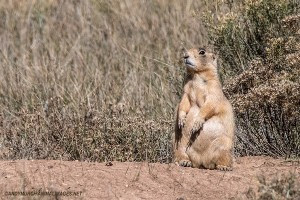
Utah Prairie Dog – Cynomys parvidens
Right next to the lodge at Bryce’s main canyon, the Uinta Chipmunks are abundant. Living in a busy tourist mecca, they have become quite bold; running back and forth through the parking lot, looking for scraps or perhaps hoping for handouts. They didn’t get any from us but they still posed long enough for some great portraits.

Uinta Chipmunk – Neotamias umbrinus
Other than more mule deer, that was it for Bryce. We probably could have found way more species if we’d waited it out but again we were feeling the weather. At night in the campground the temperature dropped to -5ºC; too cold for an unheated van.
Silent City, Utah
Our next destination was the south rim of the Grand Canyon. On the way there, we stopped at a rest stop on Highway 89 near Silent City. While wandering around looking for lizards, we found some white-tailed antelope squirrels foraging in the scrub.
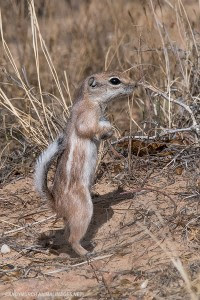
White tailed Antelope Squirrel – Ammospermophilus leucurus
While I was stalking the squirrels, I looked down at an erupting pocket gopher hole and lo and behold, up popped a head. It is tricky to identify a gopher just by his head, but based on location, it was probably a Botta’s Pocket Gopher.

Botta’s pocket gopher – Thomomys bottae
Grand Canyon National Park
Onward to the Grand Canyon… Just after dawn there were quite a few cliff chipmunks out foraging along the south rim. They were shy but I managed to sneak up on a couple. By the time the bulk of the tourists arrived, most of these were long gone.
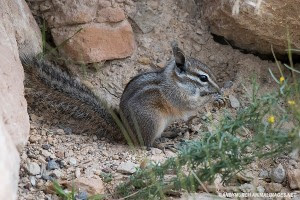
Cliff Chipmunk – Tamias dorsalis
Conversely, the rock squirrels didn’t bother getting up until the free handouts were available. A five minute walk east of the main visitor centre on the south rim, there is a rock where kids clamber around. It is crawling with tame rock squirrels that would rather have a cheesy than go foraging for pine cones. Rather sad to see but I still snapped away.

Rock Squirrel – Otospermophilus variegatus
At that same visitor centre, there were lots more elk wandering around. They seemed to be attracted to the water supply at the drinking fountains.
That evening, I popped the question to Laura. She said yes so next year’s trip to the Rockies should be even more fun  It must have been all the squirrels <3
It must have been all the squirrels <3
Saguaro National Park
The next morning we decided it was time to thaw out, so we drove down to Gila Bend and spent the following morning hiking in the Sonoran Desert. There were plenty of tracks from rodents and endless lizards running around but no mammals in plain view.
In the afternoon we arrived at Saguaro National Park West (Tucson Mountain District).The park is split in two by the city of Tucson. The westerly section is smaller but it is more pristine with a greater density of stovepipe cactuses. We spent the night fruitlessly trying to photograph packrats. We found quite a few packrat nests; easily identified by a hole surrounded by pieces of dead chola cactus. But, we only saw a tail of one animal hiding in the roots of a big cactus.
The next morning we staked out a sunny spot inside the park and were rewarded by lots of sightings of harris antelope squirrels warming up on the rocks:

Harris antelope squirrel – Ammospermophilus harrisii
One smallish, very dark coyote (likely a Mearn’s coyote) ran across the trail – clearly a different subspecies to the ones we saw earlier in the trip – but it was long gone before I raised my camera. That was it apart from all the lizards but I’ll save those for another post.
Joshua Tree National Park
Next up, Joshua tree – one of our favourite spots to camp. Bumped into a few more white-tailed antelope squirrels and some healthy looking California ground squirrels:

California Ground Squirrel – Otospermophilus beecheyi
The highlights in Joshua Tree were a couple of Merriam’s kangaroo rats that kept scurrying around our fire pit. They darted away from any light sources so I made an improvised red filter for my modelling light and then they were fairly easy to track.

Merriam’s kangaroo rat – Dipodomys merriami
Guadalupe Island, Mexico
After Joshua Tree, it was time for us to head to California to meet our guests for a great white shark diving expedition to Guadalupe Island. Tourists are not permitted to set foot on the island but it is still possible to view the pinnipeds from the liveaboard dive boat. Sprinkled along the shore line we could see a large colony of northern elephant seals and a few endemic Guadalupe Island fur seals.
Although there were constantly large great white sharks around the boat, we had the occasional visit from California sea lions. Because the water is very clear at Guadalupe, the sharks know that they don’t stand much chance of catching a sea lion. The sea lions are probably just bored but it looks as though they are actually taunting the sharks.
Redwoods National Park
Five days later we were back on land and ready to race back home. On the way, we briefly stopped at Redwoods N.P. and were surprised to not find any squirrels at all. Lots of Roosevelt elk but no rodents. I’m sure they are there in abundance but perhaps it was a bit late in the season or maybe we were just looking the other way.
Mount St Helens National Volcanic Monument
Our final stop was Mount St Helens. It was bitterly cold up around the crater but down in the valley at 4000ft there were still quite a few chipmunks on the prowl for winter provisions. I believe the ones we saw were mostly yellow-pine chipmunks.
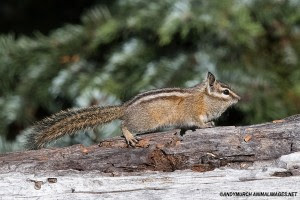
Yellow-Pine Chipmunk – Neotamias amoenus
After a final ferry ride across the Straits of Juan de Fuca to Vancouver Island, it was all over. 8500km had zipped by in a flash. Given a little more time, we likely would have seen quite a few more species but it was as much a scouting trip as anything else. Next time we’ll go a little earlier and a little slower, do a lot more spotlighting in the evenings and generally pay more attention. Regardless, it was a great trip in so many ways. We added a lot of new species to our life lists, enjoyed spectacular vistas everywhere we went and got engaged! 
Mammal List:
Dal’s porpoise
Northern elephant seal
Guadalupe fur seal
California sea lion
American bison
Grey wolf
Mountain coyote
Mearn’s coyote
Cinnamon black bear
Rocky Mountain elk
Roosevelt elk
Shiras moose
Mule deer
Pronghorn
Bighorn sheep
Mountain goat
Black-tailed jackrabbit
Desert cottontail
California ground squirrel
Red squirrel
Rock squirrel
Harris antelope squirrel
White-tailed antelope squirrel
Hopi chipmunk
Least chipmunk
Yellow-pine chipmunk
Uinta chipmunk
Cliff chipmunk
Utah prairie dog
Botta’s pocket gopher
Meriam’s kangaroo rat
Packrat
]]>

